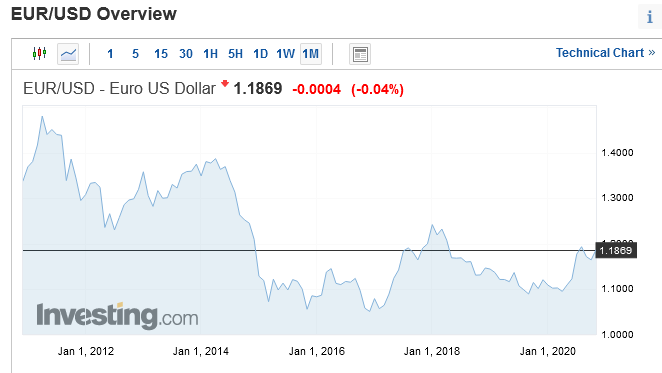There is currently a huge global focus on what is happening on the front of the Covid-19 vaccine. The sooner it is produced and distributed, the sooner the current nightmare of the economic and social situation can potentially come to an end. In general, however, experts mostly point out that, despite such hopes for the vaccine, a severe winter is likely ahead.
However, it is interesting that many people now associate the vaccine with a significantly weaker US dollar. Against this background, almost every major financial forecaster is now starting to lower its estimates of next year’s value of the US dollar. For example, the US Citigroup expects that next year the value of the US dollar against the background of the vaccine may fall by as much as 20%, which would be a very sharp fall, Bloomberg reports. The strong dollar has characterized virtually all of the past 10 years, although now they are talking about the end of such an era.
It has been common for many years for market participants to turn to the US dollar in conditions of increased uncertainty. Namely, if everything threatens to collapse and fall, then the only thing left to believe is nothing but the US dollar. Or – if investors’ confidence is shaken, the price of the US dollar will rise. Recent years have repeatedly shown that the US dollar is a more popular safe haven for the world economy at times of uncertainty than, for example, gold. At present, however, some expect that next year, as Covid-19 uncertainty diminishes, financial market participants will be able to turn their attention to something else again.
Anticipate a weaker dollar
“Buying US assets over the past decade was little or unavoidable. US corporate profits rose and the US Federal Reserve raised interest rates at a time when other central banks were still close to zero. This has resulted in the US currency remaining expensive. “Well, it could experience a big drop in prices,” analysts at investment bank Goldman Sachs told the Financial Times that the US dollar could lose 6% of its current value in the next 12 months.
Much on the currency front will be determined by the economic recovery process following this pandemic crisis. The relentless influx of pandemics in the Western world will probably not allow us to expect the fastest economic recovery expected ahead of time. At the same time, it is becoming increasingly clear that the leader in the recovery of the various world economies against the background is none other than China, which, moreover, had its origins in Covid-19. Some currency market experts point out that much of the previous post-crisis year has been spent by investors trying to gauge a stronger US economic growth story (compared to the country’s major trading partners). Meanwhile, many are currently speculating that gradually this story may change, although for the time being, of course, there may be nothing ironly forged in the stone.
“Even if the U.S. economy does well after Covid-19’s recovery, the U.S. dollar could weaken significantly as investors seek higher returns outside the U.S. and” exit “their pandemic safe havens,” Goldman added.
Morgan Stanley expects the US dollar to fall 4% by the end of next year, according to available information. The institution’s favorites, on the other hand, are the currencies of Norway, Sweden, New Zealand and Australia, which are supposed to do better when the vaccine gains momentum. The winners will also have the euro and the Russian ruble against the dollar. Morgan Stanley estimates that the price of the euro will be at the mark of 1.25 US dollars at the end of next year.
Or really
There are also observers of financial processes who point out that all the good news is already being taken into account by market participants and, perhaps, with great thoughts, but the bad news is largely being heard. This situation may be evidenced by the fact that US stocks have been at a new record for some time. Thus, there are also warnings that making any predictions against the background of the still very frequent fog is quite fragile.
Although the majority seems to be trying to predict a fall in the price of the US dollar, confidence in this trend could hardly be called very strong either. Basically, it is said that the weakening of the dollar should happen someday, although only a few people want to tie this forecast to a certain term.
The average forecast, such as the euro / US dollar, is not very strong. The median forecast of currency analysts compiled by Boomberg predicts that the price of the euro will be at the mark of 1.21 US dollars at the end of next year. That alone would be about 2.1% more than the price of the euro in US dollars now.
The caution of many forecasters is understandable. There has been a lot of talk in recent years about the same weakness of the US dollar, which has not come and has not come (apart from this year’s spring and summer). It is safer to predict the values of currencies close to the current one, so that the expressed estimate is not in the completely wrong direction.
The last time the US dollar weakened for the last time was between 2001 and the global financial crisis. During this period, the price of the euro rose from 84 US cents to almost 1.60 US dollars. During this time, investors were actively looking to invest in some overseas countries, which promised more generous returns. Accordingly, for the ongoing party, the stopcock was broken by the bursting of the 2008 financial excess bubble.
CB factor
The US Federal Reserve System (FRS) to extinguish pandemic fires, both significantly cut interest rates and engaged in liquidity printing. It is supposed to play in favor of a weaker US dollar. It is true that many others have taken similar measures – or even larger ones compared to economies. In any case, if the dollar is really weaker, then one can speculate that the FRS will be more effective in implementing its policy. It has already been reported that national central banks are setting ever lower interest rates and printing liquidity, usually with a weaker local currency. It is sometimes said that this is part of a modern and unconventional competitive currency devaluation. Namely, there is a competition that will “go lower” in terms of rates, or at least come up with the most convincing rhetoric of heating the economy. In fact, many countries have been involved in the trade struggle in this way for some time. Economic growth and inflation are deficits in many places, and in such times it is necessary to think about how to resuscitate them. Such resuscitation, if necessary, can take place at the expense of neighbors. Accordingly, if one adopts measures that weaken the currency, the other must try to counteract something in terms of additional monetary stimulus experiments or even lower rates.
King of the US dollar
The US dollar remains the dominant currency in the world. Data from the Bank for International Settlements show that about half of all cross-border loans and international loans are denominated in US dollars. Also, about 85% of all foreign exchange transactions take place directly against the US dollar. Assessing the data on world currency reserves, it can be seen that the US dollar continues to dominate on this front as well. 61% of the world’s central banks’ reserves have been denominated in US dollars. More than half of international trade also takes place in US dollars. Judgments are many and varied, but for now the king is still the US dollar. There is simply no equally liquid and relatively safe alternative.
–


